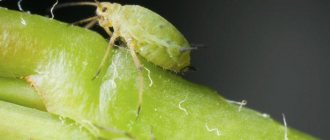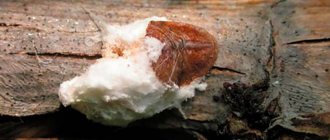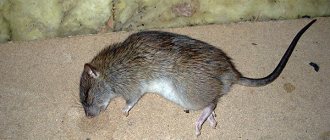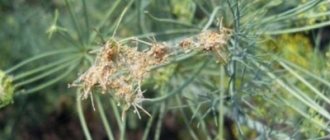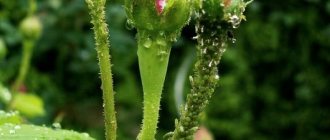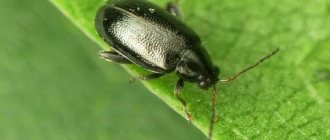What to do to make dill sprout quickly
Preparation of planting material begins a week before planting. Treatment is carried out for rapid germination and disinfection to get rid of pathogens of viral and fungal diseases.
Let's look at what the seeds are soaked in before planting.
Water
Place a cotton cloth or gauze on the bottom of the plate, sprinkle seeds and fill with filtered water. The liquid temperature for heat-loving varieties should be 20–25 °C, for others - 15–20 °C.
The water must be changed every 4 hours. During soaking, the seeds should just swell. Once 1–1.5% of the seed material has hatched, the process is complete. Shoots from such seeds appear 2-3 days earlier than when sowing dry ones.
Growth stimulants
For soaking, products containing magnesium, iron, copper, boron, molybdenum, zinc and cobalt are used. Stimulants promote the growth process and awaken the embryos. Disinfected and heated seeds are soaked in a solution, then dried, but not washed, and planted.
The most commonly used growth stimulants:
- " Zircon " is a biological product with systemic action. Activates germination and germination of seed material, increases productivity.
- " Fitosporin " is a systemic fungicide. Suppresses the proliferation of fungi and bacteria.
- " Kornevin " is a biostimulating drug that contains indolylbutyric acid.
- " Epin " is a natural bioregulator, growth and development stimulator, containing epibrassinolide.
Vodka
40% vodka not only dissolves essential oils, which promotes rapid germination, but also disinfects seeds. To do this, planting material is placed in cotton cloth and dipped in vodka for 15 minutes, no more.
Wood ash
The action of the solution is based on the high content of microelements, in particular potassium and calcium. Before soaking, prepare a solution: 2 tbsp. l. ash is poured into 1 liter of water and left for 2 days, stirring occasionally. Dill seeds are placed in the strained solution in a fabric bag for 4-5 hours.
Herbal infusions
Pour 1 tsp into a cup. chamomile, pour boiling water (90–95 °C), cool to 50 °C and soak the seeds for half an hour. You can also use aloe juice: dilute with water 1:1 and place the planting material in the infusion for a day.
This is interesting:
Areas of application for dill umbrellas.
A tasty and healthy way to fight excess weight: dill for weight loss.
Checking planting material for germination before planting
Before planting, you need to check the integrity of the seeds
Dill is one of the few herbs that loves nutritious soil. The planting site should be spacious, well-drained, sunny or partially shaded and protected from the wind - then the dill will be more fragrant. To check whether the seed material is suitable for sowing, you need to perform some manipulations.
There are two main methods for checking seed germination:
- Germination. To do this, use a damp cloth, with seeds placed between the layers. Place the napkin on a saucer, which is tightly covered with plastic wrap. The workpiece is placed in a dark place at a temperature of +23 ° C for 4 days. After the expiration date, the germination capacity of the grains can be determined. Hatched seeds are suitable for planting in the ground.
- Table salt solution. Mix half a teaspoon of salt in 500 ml of warm water. Pre-prepared seeds are placed at the bottom of the jar. After half an hour, the floating seeds should be discarded, and the settled ones should be used for further planting.
Important! The longer the seeds are stored, the longer they take to sprout. Self-harvested grains germinate faster than store-bought grains, as agricultural companies use special drying algorithms for better storage.
Disinfection
After soaking, the seeds must be pickled:
- To prevent diseases, swollen seeds are placed in a bright pink infusion of potassium permanganate for 20–30 minutes.
- Hydrogen peroxide has bactericidal properties. The seeds are placed in a 3% peroxide solution for 5–10 minutes.
- Treating seeds with the universal fungicide “Fundazol” protects the crop from many diseases. The solution is prepared in accordance with the instructions.
After treatment with fungicides and stimulants, the seeds are washed and dried until they flow.
Soaking rules
Seeds for calibration are poured into a bowl of water. Those that are unusable or empty will float and remain on the surface. They should be drained along with the water. The seed that ends up at the bottom remains there for about an hour. The remaining water is drained, and the seeds should be soaked in a 3% hydrogen peroxide solution for 5–7 minutes. There is no need to pour a lot of liquid; it is better to wet the cloth. Water for this procedure must correspond to a temperature of +25…+30°C. 3-4 times a day it is necessary to wash the seeds without removing them from the fabric to remove essential oils. To speed up germination, the fabric along with the seeds can be placed in a plastic bag and kept in a warm place for 3 days, but no more.
When will dill sprout after planting?
The first sprouts of dill, the seeds of which have been germinated, appear after 7-10 days.
Let's look at how to speed up germination. There are several factors influencing the process of seed germination:
- Warm . In warm weather, seeds germinate much faster than in early spring. At an air temperature of 20 °C, the first shoots may appear within 4 days.
- Regular watering . Lack of watering in dry weather delays the process.
- The planting depth should not be more than 2 cm.
- Another important factor is the composition and structure of the soil . Neutral, loose soil is considered the best option.
Choosing the best variety
Dill has many varieties, which are divided into early-ripening, mid-ripening and late-ripening.
The most common varieties:
- Umbrella - does not have pomp, but is distinguished by early ripening and resistance to cold;
- Brawler — bush selection variety, medium late, gives an excellent harvest;
- Firework - bush, late ripening;
- Kibray - one of the new varieties, late-ripening, heat-loving, and sensitive to low temperatures.
Early and middle varieties are suitable for planting and give an excellent harvest in any region.
Advice from experienced gardeners
To ensure that your garden has its own dill all summer, experienced gardeners recommend planting it in stages.
The first sowing can be done in April, after the snow has melted, on beds prepared in the fall (with added organic and mineral fertilizers). In the northern regions a little later, in May. These seeds do not need to be germinated; washing is sufficient. If seedlings emerge too early, they will suffer from spring frosts.
The second planting is carried out in August with seeds with preliminary soaking so that the dill has time to reach commercial ripeness.
Starting from the first spring planting, every 3 weeks a new batch of dill is sown with sprouted seeds. When one batch enters the flowering phase, the other begins to gain green mass, and so on until autumn.
In November, dill is planted before winter. Seeds for winter planting are not germinated or watered after planting. Winter dill produces its first harvest 1-2 weeks earlier than the first spring sowing.
Germination of seed material - what is it and why is it needed?
Fast-germinating seeds do not need additional stimulation . But dill seed takes a long time to germinate, and in order to avoid unexpected surprises in the form of delays, it is better to promote its germination in a timely manner.
The preliminary germination procedure allows you to realistically estimate the percentage of germination. Often, when dry sowing directly into the ground, “bald spots” appear on the beds - places where the seeds never sprouted.
From already germinated seeds, you can choose the largest and strongest sprouts, characterized by strong immunity. A plant grown from such a seed will more steadfastly survive possible weather problems in open ground, and will also be able to more effectively resist diseases and pest attacks.
How to sow dill in open ground
A plant from the umbrella family in the wild can reach one and a half meters in height. Cultivated species are grown both in the garden and on the windowsill.
The culture is used not only as a seasoning. Juices, infusions and decoctions have a positive effect on the heart, liver and genitourinary system.
The varieties differ among themselves in the time of stem formation, the shape of the rosette, the color, and the splendor of the bush.
Rapid stem formation means that the plant produces many umbels in a short time.
For early ripening dill, the period from sowing to flowering in the Moscow region takes an average of 35 days. It is necessary to pick ripe greens in a timely manner.
The culture develops equally well in greenhouses and in open beds.
Immediately after ripening, the plant enters the flowering phase; it is excellent for growing for seeds. Next spring, the fallen seeds germinate well.
"Aurora". A small bush with dark green leaves. The ripening time for greens is 30 days. Forms inflorescences late. Grows well in shaded areas and is disease resistant. Used in salads and canning.
Mid-season varieties have a longer ripening period.
This means that more green mass grows, and the umbrella forms much later. The group is the highest yielding of all.
"Hercules". The best dill for greens. A powerful bush with high productivity. Leaves regrow after cutting. The variety blooms late.
Late-ripening species are distinguished by a long period from germination to stem formation. The plant produces a large harvest of greenery.
"Kibray". Dill is bushy, the height of one plant is 40 cm. The foliage has a spicy aroma. The variety is resistant to diseases.
The crop can be sown in late autumn or early spring, as soon as the snow melts.
For the active formation of green mass, the plant needs a ten-hour daylight hours.
To achieve high germination, it is recommended to increase the seeding rate by a quarter.
According to the rules of agricultural technology, the predecessors of an annual plant should be legumes, garlic, beets or cabbage.
The area for sowing is first dug up, clods are broken, and leveled.
Dill loves moisture; you should not sow it in dry areas.
You cannot lime the beds or treat them with ash. If the top layer is dry, then the day before planting the bed is moistened.
It must be taken into account that the optimal distance between furrows with crops is 20 cm.
In the fall, the soil is dug up and humus is added at the rate of half a bucket per square. If the site is backed up by groundwater, then the bed is made high.
The soil for sowing should be loose and well fertilized. If the soil is heavy, you can add vermiculite.
Mullein or diluted bird droppings are used as fertilizer. In spring, superphosphate and potassium sulfate are added to the soil for dill.
The soil is specially prepared before planting.
For a green bed, a mixture of garden soil, sand and turf is ideal.
It is enough to dig up light sandy loam soils in the fall.
It is recommended to dig up the loamy soil again in the spring, before planting the seeds.
Green seeds usually take a long time to germinate due to their high content of essential oils.
To speed up the process, they are poured into a gauze bag and soaked in hot water.
After it has cooled, the gauze is washed under the tap.
Some summer residents advise pouring vodka over the seeds, then the processing time is reduced to fifteen minutes.
Preparing dill seeds for planting does not end there.
The swollen material is disinfected in potassium permanganate so that the plant does not get sick in the future. The seeds are immersed in a weak solution for 3 hours.
Instead of potassium permanganate, you can use aloe juice. After preparation, all that remains is to plant the dill in the beds.
Bushes can be obtained by seed and seedling methods. Seeds germinate in early spring and late autumn.
Bush varieties are planted in peat tablets or pots and grown in apartment conditions for a couple of weeks.
Then the plant is transplanted into open ground, planting interval is 30 cm.
Both before sowing and before planting, it is necessary to water the furrows.
The material is buried and covered with earth. No watering needed.
If there is a threat of return frosts in early spring, you can cover the plantings with lutrasil.
The annual plant is sown for the first time at the end of April, using only dry seeds.
Mature bushes are pulled out by the roots. Subsequent crops are repeated at intervals of 20 days.
The last time greens are sown is in winter, on very cold soil.
Planting dill in open ground with seeds is not difficult. The material is buried 2 cm into the furrow.
A thin layer of humus is poured on top and the furrow is covered with earth.
A stream of water will wash the seeds and deprive the soil of oxygen, so necessary for germination, so watering is not required.
Planting dill in the middle zone begins on April 20.
Early ripening varieties need moist soils. No additional fertilizing is required. The bush grows in 25 days.
It is necessary to pick off the greens so that the plant goes into umbrellas as soon as possible.
If powerful bushes are needed, the furrows with plantings are thinned out. The resulting seeds are suitable for planting this season.
In May, when the earth warms up, you can plant the greens that were previously growing on the windowsill in open ground.
Sowing dill in summer
The plant is convenient to sow in beds vacated by radishes or winter garlic.
To save space, you can plant seeds between the rows of vegetable plantings.
The seeds are buried in moist soil.
The beds are watered after the first shoots.
To make dill sprout faster, you need to buy seeds with a good shelf life.
In the summer, caring for bushes consists of moistening the soil and weeding.
If the crop is grown for umbrellas for preservation, then the greens are not processed at all. It takes a month to shoot.
There is an opinion that sowing dill in late autumn is the most convenient way: there is no need to soak the seeds.
The bed is dug up 20 cm even before frost sets in.
It is necessary to give preference to the area that will warm up faster than others in the spring. During digging, peat and superphosphate are added.
The seeds are lowered a little deeper than usual.
Sprinkle the top with a pre-prepared light substrate and compact it slightly.
The bed is mulched with peat, straw, humus or dry leaves.
Dill is not covered with geotextiles before winter.
If it rains in late autumn, the beds are covered for a while with film.
In spring, melt water and the sun will give the seeds strength for friendly shoots.
Plants obtained in this way are juicier and larger. That's why summer residents love planting dill for the winter.
Dill for greens is cut until flowering stems grow. Umbrellas are needed for salting.
They are picked before the seeds acquire a milky-waxy color. This takes 60 days from the date of sowing.
Leaves are cut or torn off in dry weather in the morning. The greens are put in the refrigerator or dried.
Umbrellas are rolled into sheaves and dried in the open air.
Planting dates range from mid-March to mid-May.
According to the lunar calendar 2022, the following days are considered prosperous:
- March – 3-6, 17, 18, 22, 27-30
- April – 5-7, 10-14, 18, 19, 23, 25-29
- May –2-6, 15-17, 24-26, 30 and 31
- June – 1-4, 6-8, 12, 13, 22, 23, 26-30
- July – 1-5, 9, 10, 14, 15, 23-31
- August –1, 2, 5-7, 10-16, 21-26, 28 and 29
- September – 3, 6-13, 18-25, 30-31
- October -4-10, 13, 14, 17-23, 26, 27 and 31
- November –1-6, 10-13, 16-19, 22-24, 27-30
You can sow dill in spring, autumn, and summer. Only summer sowings are more suitable for obtaining seeds.
Experienced gardeners admit that both dry and pre-prepared seeds can be sown. Much depends on the soil, humidity and weather conditions. However, seeds that have been previously calibrated, soaked, pickled, hardened and kept in a nutrient solution will begin to germinate more confidently and amicably. This means the harvest will be bountiful.
How to prepare seeds:
- We harden - place the seeds in the refrigerator for a week.
- We carry out disinfection - place the seeds for half an hour in a weak solution of potassium permanganate.
How to germinate seeds:
- Due to the content of essential oils, dill seeds have low germination. To improve this indicator, the seeds are poured with warm water (50 degrees) for two days. As it cools, the water is changed every 8 hours.
- After two days, the seeds are removed from the water, laid out on gauze and covered with a damp cloth.
- Seeds in gauze are placed on a plate and left at room temperature for 4 days. As soon as the seeds sprout, the planting material is slightly dried.
How to sow dill to get a good harvest:
- It is worth sowing at the rate of seeds per 1 square meter. m beds – 1 gr. for spring planting and 2 gr. for planting before winter.
- In 1-2 days, the bed is watered abundantly.
- Before sowing dill, beds 5 cm wide are made. And they should also be well watered, each furrow separately.
- Sowing is carried out to a depth of 1-2 cm.
- Seeds are sown not in a straight line, but in a zigzag pattern. This allows plants to have room to grow and develop.
- The top of the crop is covered with a thin layer of mulch, humus or soil.
- The planting is not watered! There is moisture in the soil. And it is enough for seed germination.
- Good lighting. This means that dense plantings should be thinned out.
- Moderate soil moisture. The soil in the beds should not be allowed to dry out. It is worth setting a watering schedule (1-2 times a week) taking into account weather conditions and soil quality (in case of heavy dew, rain and fog, watering can be reduced. If the soil is light and does not have drainage that would retain moisture, watering should be increased).
- Plant nutrition depends on the time of maturation. For example, early varieties do not need to be fertilized. Medium ones are fed with nitrophoska and urea when the plants have 2-3 true leaves (10-15 grams of fertilizer are needed per 1 sq. m). Late varieties are fed twice during the entire growing season. The first time - when there are 2-3 leaves. The second time - 20-25 days after the first application of fertilizers to the soil. Dill is fed with potassium salt (15g) and urea (20g) per 3-4 square meters. m.
- When the shoots appear, you need to start weeding to a depth of 5-7 cm.
- In hot weather, canopies are made over the plants.
Soil requirements
Dill can grow on any type of soil, but it will be juicy and spreading only on fertile, loose soil rich in organic matter. Dill does not grow in acidic soils or when water stagnates.
Immediately before planting, it is not recommended to add ash or lime to the bed, as this can lead to reddening of the green mass.
Only on fertile soil will dill grow juicy, green, and aromatic
Extra comfort
Just proper soaking is not always enough. It is important to meet a number of other conditions so that the greens do not “be capricious”:
- When soaking seeds, add microelements or growth stimulants to the solutions, which include boron, iron, magnesium, copper, molybdenum, cobalt, zinc.
- The site should be sunny and the soil should be well heated.
- If it is still cold, then you need to plant under film, which is used to cover the area a couple of weeks before planting so that the soil warms up.
- A couple of days before planting the seeds, add humus or a little mullein to the soil, plus add a handful of ash - the crop loves alkaline soil.
- Water regularly and abundantly.
Good germination of dill depends on various factors. It is very important to properly prepare green seeds for planting. However, preparing the soil and caring for the seedlings are no less important so that the harvest does not take long to arrive.
